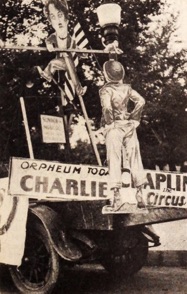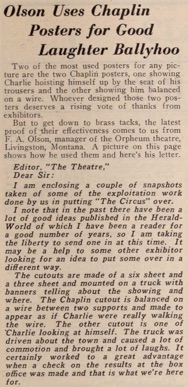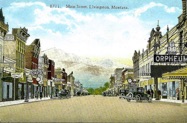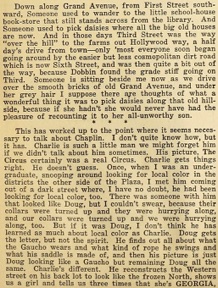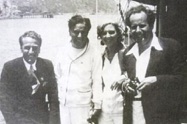The Circus 1927 1928 1929 next previous
The Circus Clippings 351/376
Robert Rose, Film Spectator, Hollywood, Cal., November 17, 1928.
Grigori Aleksandrov, Charles Chaplin, Paulette Goddard and
Sergej Eisenstein in California, 1930s, enfilme.com
& Olson Uses Chaplin Posters for Good Laughter Ballyhoo
Two of the most used posters for any picture are
the two Chaplin posters, one showing Charlie hoisting himself
up by the seat of his trousers and the other showing him
balanced on a wire. Whoever designed those two posters
deserves a rising vote of thanks from exhibitors.
But to get down to brass tacks, the latest proof of their
effectiveness comes to us from F. A. Olson, manager
of the Orpheum theatre, Livingston, Montana. A picture on this
page shows how he used them.
(...) Photo, Exhibitors Herald and Moving Picture
World, Oct. 13, 1928
& Orpheum Theatre (right) on Main Street, Livingston,
Montana, undated, postcard in color, Vanishing Movie Theatres,
Don Lewis
Orpheum Theatre, Main Street, Livingston
& Down along Grand Avenue, from First Street southward,
Someone used to wander to the little school-house
book-store that still stands across from the library. (...)
* * *
This has worked up to the point where it seems
necessary to talk about Chaplin. I don‘t quite
know, but it has. Charlie is such a little man we might forget
him if we didn‘t talk about him sometimes. His picture,
„The Circus“ certainly was a real Circus. Charlie gets things
right. He doesn‘t guess. Once, when I was an
undergraduate, snooping around looking for local color
in the districts the other side of the Plaza, I met
him coming out of a dark street, where, I have no doubt,
he had been looking for local color, too. There was
someone with him that looked like Doug, but I couldn‘t swear,
because their collars were turned up and they were
hurrying along, and our collars were turned up and we were
hurrying along, too. But if it was Doug, I don‘t think
he has learned as much about local color as Charlie. Doug
gets the letter, but not the spirit. He finds out all about
what the Gaucho wears and what kind of rope he swings
and what his saddle is made of, and then his picture
is just Doug looking like a Gaucho but remaining Doug
all the same. Charlie‘s different. He reconstructs
the Western street on his back lot to look like the frozen
North, shows us a girl and tells us three times
that she‘s GEORGIA, and I, who have been to Nome and
St. Michael, and Seward, and Juneau and Ketchikan,
feel suddenly that everything is right with the world again,
that we are all sixteen and going hunting for gold. . . .
Critics and aesthetes explain these things, but I don‘t attempt to.
(...) HOLLYWOOD VIGNETTES By F. T. D., Film
Spectator, Hollywood, Cal., Nov. 3, 1928
„Deteriorating“
Editorial content. „Eisenstein‘s Ideas
By Robert Rose“ (...)
It might be interesting for the great family of Spectator
readers to know that Eisenstein considers Eric von
Stroheim to be the greatest American director and his Greed,
with its gloomy realism, he selects as one of the
best pictures in the film productions of the whole world.
-
D.W. Griffith is in his eyes the classical director,
Charlie Chaplin the greatest film artist, and his Gold Rush
the most interesting picture he ever produced. In The
Circus he finds, to his sorrow, that Charlie is deteriorating,
but he also hopes that his next picture will again put
Charlie on the pedestal of the greatest artistic achievement.“ (...)
Redaktioneller Inhalt
The Circus 1927 1928 1929 next previous

